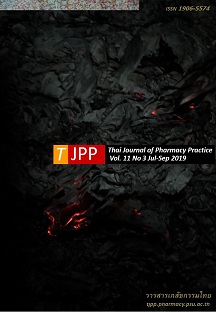ผลของมาตรการแก้ปัญหาการโฆษณาอาหารและยาที่ผิดกฎหมายในวิทยุท้องถิ่น
Main Article Content
บทคัดย่อ
วัตถุประสงค์: เพื่อศึกษาผลของการจัดการปัญหาโฆษณาอาหารและยาที่ผิดกฎหมายในสถานีวิทยุท้องถิ่นของจังหวัดพัทลุงด้วยการลงนามในข้อตกลง (memorandum of understanding: MOU) การตรวจสอบ-ขอความร่วมมือ และการบังคับใช้กฎหมาย วิธีการ: การวิจัยครั้งนี้ดำเนินการในสถานีวิทยุประเภทธุรกิจของจังหวัดพัทลุงจำนวน 15 สถานี ในระยะเวลา 9 เดือน มาตรการในการแก้ปัญหามี 3 ระยะ ระยะแรก คือ การให้ความรู้ในเรื่องการโฆษณาอาหารและยาให้ถูกกฎหมาย และจัดทำ MOU กับผู้ประกอบการในการปฏิบัติตามกฎหมาย หลังการลงนามใน MOU 4 เดือน ผู้วิจัยแจ้งข้อมูลย้อนกลับแก่สถานีถึงผลการตรวจสอบการกระทำที่ผิดกฎหมาย พร้อมทั้งแจ้งค่าปรับที่ต้องจ่ายหากถูกดำเนินคดีจริง และขอความร่วมมือจากผู้ประกอบการในการปฏิบัติตามกฎหมาย ในระยะที่สามหลังการลงนามใน MOU 7 เดือน ผู้วิจัยซึ่งเป็นพนักงานเจ้าหน้าที่ใช้มาตรการบังคับใช้กฎหมายกับผู้กระทำผิด และแจ้งไปยังคณะกรรมการกิจการกระจายเสียง กิจการโทรทัศน์ และกิจการโทรคมนาคมแห่งชาติ (กสทช.) ตลอดจนมีการตรวจเยี่ยมสถานีวิทยุโดยพนักงานเจ้าหน้าที่ตามกฎหมายอาหารและยา และ กสทช. ผู้วิจัยตรวจสอบการโฆษณาที่ผิดกฎหมายจากทุกสถานีโดยบันทึกรายการของสถานีตลอดเวลาที่ออกอากาศ จำนวน 2 วันต่อสถานีได้แก่ วันจันทร์ถึงศุกร์ 1 วัน และวันเสาร์หรืออาทิตย์อีก 1 วัน โดยเลือกวันเก็บข้อมูลมาอย่างสุ่ม การตรวจสอบทำ 4 ครั้ง คือ เวลา 1 เดือนก่อนการลงนามใน MOU และหลังการลงนามใน MOU เป็นเวลา 1, 5 และ 9 เดือน ผลการวิจัย การให้ความรู้และจัดทำ MOU ไม่สามารถลดปริมาณการโฆษณาที่ผิดกฎหมายลงได้เลย เมื่อใช้มาตรการเฝ้าระวังโฆษณาที่ผิดกฎหมายและให้ข้อมูลย้อนกลับ พบว่าอัตราการโฆษณาที่ผิดกฎหมายลดลงประมาณร้อยละ 30 ถึง 40 (ขึ้นกับหน่วยนับว่าเป็นจำนวนผลิตภัณฑ์ที่โฆษณา จำนวนครั้งของการโฆษณา และจำนวนชิ้นของการโฆษณา) หากใช้มาตรการบังคับใช้กฎหมายร่วมด้วยพบว่า อัตราการโฆษณาที่ผิดกฎหมายลดลงได้อีกร้อยละ 16-24 โดยรวมการแทรกแซงทั้งหมดทำให้การโฆษณาอาหารและยาที่ผิดกฎหมายลดจาก 1045 ครั้งต่อ 30 วันสถานีในช่วงก่อนการวิจัยเหลือเพียง 46 ครั้งต่อง 30 วันสถานี ส่วนจำนวนผลิตภัณฑ์ที่โฆษณาอย่างผิดกฎหมายลดลงจาก 66 เหลือ 8 ผลิตภัณฑ์ในช่วงเวลาเดียวกัน ส่วนจำนวนชิ้นโฆษณาที่ผิดกฎหมายลดจาก 124 เหลือ 14 ชิ้นในช่วงเวลาเดียวกัน สรุป: ปัญหาการโฆษณาที่ผิดกฎหมายทางวิทยุท้องถิ่นไม่สามารถแก้ได้ด้วยการให้ความรู้และการจัดทำ MOU แต่การดำเนินการดังกล่าวร่วมกับการใช้มาตรการเฝ้าระวังปัญหา-ให้ข้อมูลย้อนกลับ ทำให้ปัญหาลดลงอย่างมาก การใช้มาตรการบังคับใช้กฎหมายร่วมด้วยจะช่วยให้การแก้ไขปัญหาสัมฤทธิ์ผลยิ่งขึ้น
Article Details
ผลการวิจัยและความคิดเห็นที่ปรากฏในบทความถือเป็นความคิดเห็นและอยู่ในความรับผิดชอบของผู้นิพนธ์ มิใช่ความเห็นหรือความรับผิดชอบของกองบรรณาธิการ หรือคณะเภสัชศาสตร์ มหาวิทยาลัยสงขลานครินทร์ ทั้งนี้ไม่รวมความผิดพลาดอันเกิดจากการพิมพ์ บทความที่ได้รับการเผยแพร่โดยวารสารเภสัชกรรมไทยถือเป็นสิทธิ์ของวารสารฯ
เอกสารอ้างอิง
2. National Statistical Office. Media survey. Bangkok: Ministry of Technology and Communications; 2008.
3. Kasikorn Research Center. In 2015 media revived, various media complete for business as media buying behavior of entrepreneurs change [online]. 2015 [cited Dec 20, 2017]. Available from: www.kasikornresearch .com/TH/K-conAnalysis/Pages/ViewSummary.aspx? docid=33729.
4. National Broadcasting and Telecommunications Commission. Authorized radio stations [online]. 2018 [cited May 17, 2018]. Available from: broadcast.nbtc. go.th/radio/.
5. Tangchroensathien V, Kongsawat S, Wadwongtham A, Eurchaikul C, Eupamayun Y, Taruekachong S, et al. Survey on radio advertisement of food, drug and cosmetics in 1993 [online]. 1993 [cited 2014 Sept 24]. Available from: kb.hsri.or.th/dspace/.
6. Suwanmanee O, Lerkiatbundit S. Illegal advertising of products classified as drugs by law among local radios. Thai Journal of Pharmacy Practice 2011; 3: 41-55.
7. Chandrawongse M. Situation and impacts of drug and health product advertisements with legal problems on community radio broadcasts toward consumers in Chiang Mai province [independent study]. Chiang Mail: Chiang Mai University; 2011.
8. Lomas K, Chanthapasa K. The situation of radio advertisement of drug and food claimed as drug in Phraibueng municipality, Sisaket province. Isan Jour- nal of Pharmaceutical Sciences 2012; 8: 55-60.
9. Ampant P. Situations, problems and solutions to problems of the broadcasting radio station of Sisaket province in advertising health products. Research and Development Health System Journal 2015; 8: 26-37.
10. Foundation for Consumers. Unfolding unlawful health product ads in era of the National Council for Peace and Order [online]. 2015 [cited Jan 8, 2016]. Available from: www.consumerthai.org/2015/index.php/news/ffc -news/19-571106001.html.
11. Rujirayunyong T. Situation of illegal advertising of health products among local radios in Lopburi in the era of the National Council for Peace and Order (NCPO). Thai Journal of Pharmacy Practice 2015; 7: 189-99.
12. Wongsao L. Risk management for reducing the problems of unlawful advertisings of health products by local radios: the case of Saraburi. In: The College of Pharmaceutical and Health Consumer Protection (CPHCP) of Thailand and Health Consumer Protec- tion Program, editors. Proceedings of the conference for presenting academic work in the training program for board certificates in pharmaceutical and health consumer protection in the second semester; 2015 May 27-29; Bangkok, Thailand: CPHCP; 2015. p 28-9.
13. Surin N Surveillance of illegal advertisings of health products among community radios in Muangpan ubdistrict, Pan district in Lumpang. In: The College of Pharmaceutical and Health Consumer Protection (CPHCP) of Thailand and Health Consumer Protection Program, editors. Proceedings of the conference for presenting academic work in the training program for board certificates in pharmaceuti- cal and health consumer protection in the second semester; 2015 May 27- 29; Bangkok, Thailand: CPHCP; 2015. p 45-6.
14. Wiriyanutai P. Situation of advertisings of health products among community radios in Ngao district in Lumpang. In: The College of Pharmaceutical and Health Consumer Protection (CPHCP) of Thailand and Health Consumer Protection Program, editors. Proceedings of the conference for presenting academic work in the training program for board certificates in pharmaceutical and health consumer protection in the second semester; 2015 May 27-29; Bangkok, Thailand: CPHCP; 2015. p 54-5.
15. Chanakha K. Prevalence of illegal health product advertisements on local radio broadcasts in Amphur Mueang, Buriram Province. Thai Journal of Pharmacy Practice 2016; 8: 435-41.
16. Khanteekul N. Prevalence of illegal advertising of food and drugs among radio broadcasts in Chiang Mai after enforcing legal measures to the problem. Thai Journal of Pharmacy Practice 2017; 8: 322-8.
17. Vittayarat K, Lerkiatbundit S, Chaisumritchoke ST. Process of health product advertising among the operators of local radios: a qualitative approach. Thai Journal of Pharmacy Practice 2016; 8: 68-92
18. Jangjai D, Lerkiatbundit S. Effectiveness of the interventions for reducing illegal advertising of health products among local radio stations. Thai Journal of Pharmacy Practice 2014; 6: 22-40.
19. Rujirayunyong T. Control of illicit advertising of health products by the involvement of network of partners in Lopburi. In: The College of Pharmaceutical and Health Consumer Protection (CPHCP) of Thailand and Health Consumer Protection Program, editors. Proceedings of the conference for presenting academic work in the training program for board certificates in pharmaceutical and health consumer protection in the second semester; 2015 May 27-29; Bangkok, Thailand: CPHCP; 2015. p 47-9.
20. Ajzen I. Behavioral interventions based on the theory of planned behavior [online]. 2006 [cited Nov 1, 2017]. Available from: www.people.umass.edu/aizen/.
21. Landis JR, Koch GG. The measurement of observer agreement for categorical data. Biometrics 1977; 33: 159–74.
22. Dunn OJ. Multiple comparison among means. J Am Stat Assoc 1961; 56: 52–64.
23. Bodenheimer T. Helping patients improve their health-related behaviors: what system changes do we need? Dis Manag 2005; 8: 319-30.
24. Lorig KR, Holman H. Self-management education: History, definition, outcomes, and mechanisms. Ann Behav Med 2003; 26: 1-7.
25. Melin I, Karlström B, Berglund L, Zamfir M, Rössner S. Education and supervision of health care profess- ionals to initiate, implement and improve management of obesity. Patient Educ Couns 2005; 58: 127-36.


